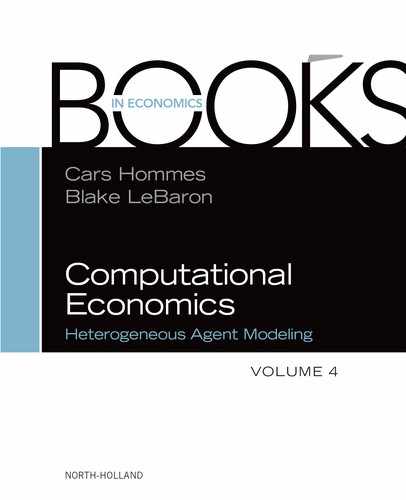Table of Contents
Introduction to the Handbook of Computational Economics, Volume 4, Heterogeneous Agent Modeling
Chapter 1: Heterogeneous Expectations and Micro-Foundations in Macroeconomics
2. Expectations Operators and Bounded Rationality
3. Equilibria with Heterogeneous Expectations
Chapter 2: Agent-Based Macroeconomics
2. Design of Agent-Based Macroeconomic Models
3. Comparison of Existing Agent-Based Macroeconomic Models
Appendix A. Summary of Selected Agent-Based Macroeconomic Models
Chapter 3: Endogenous Firm Dynamics and Labor Flows via Heterogeneous Agents
2. Dynamics of Team Production
3. From One Team to Six Million Firms, Computationally
4. Model Variations: Sensitivity and Robustness
Appendix A. Generalized Preference Specifications
Appendix B. Generalized Compensation and Nash Stability
Appendix C. Sensitivity to ‘Sticky’ Effort Adjustment
Appendix D. Extension: Stabilizing Effect of Agent Loyalty
Appendix F. Extension: Effort Monitoring and Worker Termination
Chapter 4: Heterogeneous Agents in the Macroeconomy: Reduced-Heterogeneity Representations
2. The Economic Problem and Notations
7. Comparison with Other Approach Using Perturbation Methods
Chapter 5: Heterogeneous Agent Models in Finance
2. HAMs of Single Asset Market in Discrete-Time
3. HAMs of Single Asset Market in Continuous-Time
4. HAMs of Multi-Asset Markets and Financial Market Interlinkages
5. HAMs and House Price Dynamics
6. HAMs and Market Microstructure
7. Conclusion and Future Research
Chapter 6: Models of Financial Stability and Their Application in Stress Tests
2. Two Approaches to Modeling Systemic Risk
3. A View of the Financial System
4. Leverage and Endogenous Dynamics in a Financial System
5. Contagion in Financial Networks
6. From Models to Policy: Stress Tests
7. Microprudential Stress Tests
8. Macroprudential Stress Tests
9. The Future of System-Wide Stress Tests
Chapter 7: Agent-Based Models for Market Impact and Volatility
2. The Statistics of Price Changes: A Short Overview
4. The Santa-Fe “Zero-Intelligence” Model
5. An Improved Model for the Dynamics of Liquidity
6. Walrasian Auctions and the Square-Root Law
7. The Information Content of Prices
8. Conclusions and Open Problems
Chapter 8: Empirical Validation of Agent-Based Models
2. Estimation of Agent-Based Models in Other Fields
Chapter 9: Heterogeneous Agent Modeling: Experimental Evidence
2. Heterogeneity and Bounded Rationality in Decision Making
3. Heterogeneity and Monetary Policy
4. Heterogeneity in Equilibrium Selection
Chapter 10: Levels of Reasoning in Keynesian Beauty Contests: A Generative Framework
2. An Overview of Experimental Economics
3. The Keynesian Beauty Contest: A Generative Framework for Archetypal Games in Economics
Chapter 11: Empirical Analyses of Networks in Finance
2. A Brief Historical Perspective About the Use of Network Science in Economics and Finance
3. Network Approaches to Financial Stability: The Interbank Market
4. Networks and Information Filtering
5. Indirect Channels of Contagion
Appendix A. Basic Concepts in Network Science
Appendix B. Econometrics Systemic Risk Measure
Chapter 12: Heterogeneity and Networks
3. The Theory of Network Formation
4. Networks and Individual Behavior
2. Agent-Based Computational Economics: Overview
3. Early ACE Research on Electric Power Systems
4. Transactive Energy Systems Research: Overview
5. ACE Support for TES Research on Demand Response
Part 6: Perspectives on Heterogeneity
Chapter 14: Modeling a Heterogeneous World
1. Heterogeneity and Standard Economics
2. Heterogeneity in Microeconomics: Fish Markets
3. Heterogeneity in Financial Markets: The Implications of a Volatility Shock
